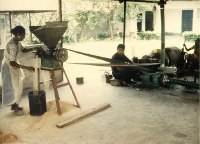A 19th century invention may hold the key to 21st century energy saving.
Clean, renewable, with heat as their only byproduct, Stirling engines sit on top of other energy sources. Invented at the beginning of the 19th century the Stirling Engine enjoyed its heyday until the combustion engine came along.

Ricemill powered by a Stirling engine
Although much more noisy, smelly and unreliable, the gas engine eventually took over and the Sterling engine was dismissed as an old-fashioned, inefficient oddity.
Today’s sterling engines have evolved a long way. High temperatures alloys and other manufacturing processes have dramatically increased the power to weight ratio, making the Stirling a viable alternative to engines relying on fossil fuels.
Stirling engines are available for pumping water or powering agricultural or industrial machines, and also produce electricity. Simply put, the way Stirling engines work is by converting the heat energy in hot air circulating in the engine into mechanical energy. To produce electricity the engine has to be attached to an alternator, the power produced can then be stored in batteries. Stirlings are completely clean and emit no harmful gases, only heat, which can be used for heating houses, greenhouses or water.
Links
HowStuffWorks on the Stirling Engine
WhisperGen Stirling driven heat and power generator
Stirling tech’s ST5 Stirling engine
The American stirling
Company sells books, kits, mini Stirling engines, and has more info, groups, links
